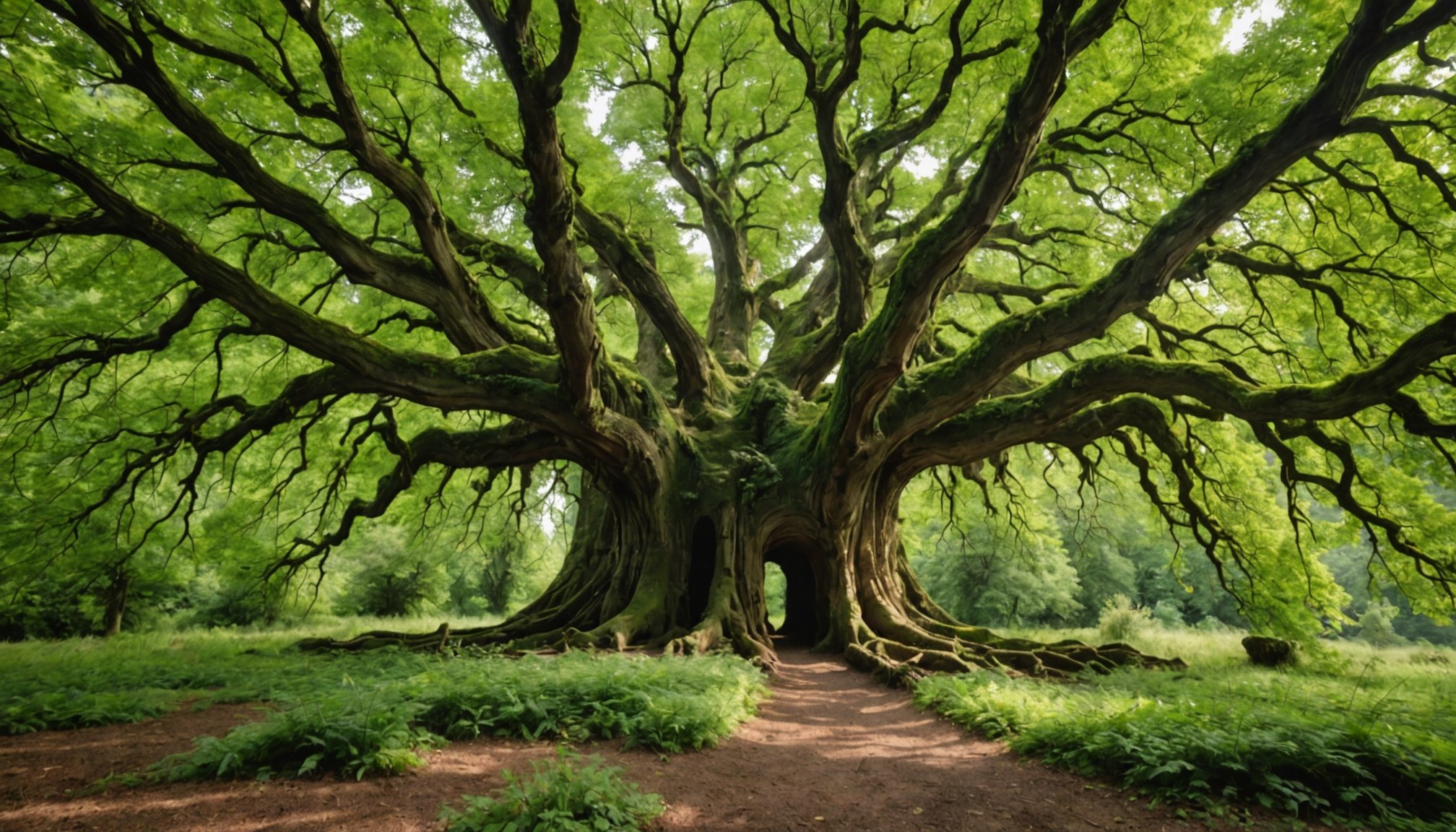Preserving the Past: A Deep Dive into the UK’s Initiatives and Strategies for Protecting Ancient Trees
The Significance of Ancient Trees in the UK
Ancient trees, often hundreds or even thousands of years old, are more than just natural wonders; they are irreplaceable components of the UK’s ecosystem, biodiversity, and cultural heritage. These trees, such as the iconic oak trees and veteran trees, support a wide range of plant and animal life, act as significant carbon stores, and play a crucial role in local communities where they have stood for generations.
For instance, the Darwin Oak, a 550-year-old tree in Shropshire, is not only a biodiversity hotspot but also holds historical significance, as it is believed that Charles Darwin may have sat under its branches. However, despite their importance, these ancient trees lack automatic legal protection, making them vulnerable to development threats and other human activities[1].
This might interest you : Unveiling the UK’s Tactics for Curbing Wildlife Disease Transmission from Domestic Pets to Wild Fauna
Legislative Efforts to Protect Ancient Trees
In recent years, there has been a significant push for stronger legal protections for ancient trees in the UK. One of the most promising developments is the proposal for a Tree Protection Bill submitted to the Northern Ireland Assembly. This bill aims to strengthen the protection provided by Tree Preservation Orders (TPOs), create a new ‘Heritage Tree’ designation, and safeguard these heritage trees and ancient woodlands from development threats[1].
Key Provisions of the Proposed Bill
- Strengthening TPOs: Current TPOs are based on amenity values, which primarily consider the aesthetic appeal of trees. The new bill would expand these protections to include ecological and cultural significance.
- Heritage Tree Designation: This new designation would provide special legal protections for trees that are deemed to have significant historical, cultural, or ecological value.
- Protection from Development: The bill would ensure that ancient woodlands and heritage trees are safeguarded from threats posed by urban development and infrastructure projects.
This initiative is part of the broader Living Legends campaign by the Woodland Trust, which has garnered over 100,000 signatures and significant public support. The campaign highlights the need for nationwide legal protection for the UK’s oldest and most special trees[1][2].
In the same genre : Ultimate guide for uk homeowners: crafting perfect bat boxes tailored for your local environment
Partnerships and Funding for Conservation
The protection and restoration of ancient woodlands and trees are not solely the responsibility of legislative bodies; they also require substantial funding and collaborative efforts. One notable example is the partnership between E.ON Next and the Woodland Trust.
E.ON Next and Woodland Trust Partnership
E.ON Next has committed to donating at least £500,000 to the Woodland Trust over the next three years. This funding will support woodland restoration projects, including the removal of invasive species and the creation of habitats for native species. This partnership is a prime example of how innovation in the energy sector can contribute to environmental conservation[3].
Practical Conservation Efforts
Beyond legislative and financial support, practical conservation efforts are crucial for the long-term protection of ancient trees and woodlands.
Management Strategies for Ancient Forests
Epping Forest, one of the few large ancient forests in the UK, is managed according to a carefully written strategy. This strategy includes:
- Habitat Management: Different habitats within the forest, such as ancient semi-natural woodland, wood-pasture, and heathlands, are managed to ensure their health and sustainability.
- Community Involvement: Local communities are involved in the management process to ensure that the forest remains a vital part of their heritage and environment[4].
Agroforestry and Integrated Farm Management
In Northumberland, the Great Northumberland Forest initiative is promoting agroforestry as a key component of integrated farm management. This approach involves planting trees as part of a livestock-tree system, which can improve livestock health and provide additional food resources. The initiative includes:
- Promoting Knowledge: Creating agroforestry demonstration farms and establishing a regional practitioner group to support farmers.
- Policy Integration: Integrating relevant government policies and maintaining funding for agroforestry.
- Tailored Advice: Providing farmers with accessible and tailored advice using current knowledge-exchange practices[5].
Challenges and Community Engagement
Despite the progress made, there are several challenges that need to be addressed to ensure the effective protection of ancient trees.
Urban Construction and Lack of Care
In areas like Kingston, urban construction and a lack of proper care are significant threats to tree health. Local ecologist Alison Fure highlights the devastating impact of building works and the need for better aftercare for newly planted trees. For instance, out of the trees planted by the council in Kingston, all but two have died due to inadequate aftercare[2].
Community Support and Awareness
Community support is vital for the conservation of ancient trees. The Woodland Trust’s Living Legends campaign has shown that public awareness and support can drive significant change. For example, a YouGov poll indicated that 88% of people in Britain support legally protected heritage status for ancient trees after the felling of the Sycamore Gap tree[2].
Insights into Effective Conservation
Here are some key insights and practical tips for effective tree conservation:
Key Insights
- Legal Protections: Strong legal protections, such as those proposed in the Tree Protection Bill, are essential for safeguarding ancient trees from development threats.
- Community Engagement: Involving local communities in conservation efforts can ensure that trees remain a valued part of the local heritage.
- Funding and Partnerships: Collaborations between organizations and funding commitments, like the E.ON Next and Woodland Trust partnership, are crucial for supporting restoration projects.
- Agroforestry: Integrating trees into farm management can provide numerous benefits for biodiversity, climate change mitigation, and livestock health.
Practical Tips
- Proper Aftercare: Ensure that newly planted trees receive proper aftercare, including soil improvement and protection from damage.
- Education and Awareness: Educate the public about the importance of ancient trees and the need for their protection.
- Support Local Campaigns: Support local campaigns and petitions that aim to protect ancient trees and woodlands.
- Sustainable Practices: Promote sustainable practices in urban development and agriculture to minimize the impact on ancient trees.
Table: Comparison of Conservation Efforts
| Initiative | Location | Key Objectives | Methods | Impact |
|---|---|---|---|---|
| Tree Protection Bill | Northern Ireland | Strengthen TPOs, create Heritage Tree designation, protect from development | Legislative changes | Enhanced legal protection for ancient trees |
| E.ON Next and Woodland Trust Partnership | UK-wide | Fund woodland restoration, remove invasive species, create habitats for native species | Financial support, collaborative projects | Restoration of ancient woodlands, increased biodiversity |
| Great Northumberland Forest | Northumberland | Promote agroforestry, integrate trees into farm management | Demonstration farms, policy integration, tailored advice | Improved livestock health, increased biodiversity, climate change mitigation |
| Epping Forest Management | Epping Forest | Manage different habitats, involve local communities | Careful management strategy, community involvement | Sustainable management of ancient forest, preservation of habitats |
The preservation of ancient trees in the UK is a multifaceted effort that requires legislative support, financial commitments, practical conservation strategies, and community engagement. As we move forward in the face of the climate crisis, it is imperative that we prioritize the protection of these irreplaceable natural and cultural assets.
In the words of Darren Moorcroft, CEO at the Woodland Trust, “Together, we’ll harness the power of innovation in the energy sector to create a greener future. This collaboration will be instrumental in the restoration of ancient woodlands, which once lost, are irreplaceable.”[3]
By supporting initiatives like the Living Legends campaign, advocating for stronger legal protections, and engaging in practical conservation efforts, we can ensure that these ancient trees continue to thrive for generations to come. As Jane Ritchley, a Hinchley Wood resident, aptly put it, “Our beautiful oak trees support countless species of wildlife as well as helping in the fight against climate change.”[2]
Let us dive into this critical mission with determination and collective action, recognizing the profound impact that preserving ancient trees can have on our world.
Future Directions for Ancient Tree Protection
The future of ancient tree protection hinges on emerging trends and forward-thinking strategies. As these venerable giants face growing challenges, innovative conservation methods are increasingly crucial. Emphasising research and data collection helps tailor initiatives to address specific ecological needs. By leveraging new technologies, conservation efforts can be more precise and effective, ensuring ancient trees continue to flourish.
Long-term strategies involve encouraging collaboration among stakeholders, from local communities to international conservation bodies. This comprehensive approach fosters a network of resources and expertise, benefiting ancient tree conservation on multiple levels. Sharing knowledge and best practices heightens the impact of preservation efforts and galvanises public support.
Furthermore, the development of innovative conservation techniques allows for adaptive management practices. For example, integrating climate modelling with traditional conservation methodologies enables the proactive addressing of environmental changes. Such adaptability ensures that preservation goals align with dynamic ecological landscapes.
As we look ahead, the emphasis is on combining technological advancements with traditional wisdom to create robust, sustainable conservation frameworks. By doing so, ancient trees can thrive, continuing to enrich our biodiversity and heritage. These collaborative, innovative strategies will chart a promising path forward in safeguarding these natural treasures for future generations.









